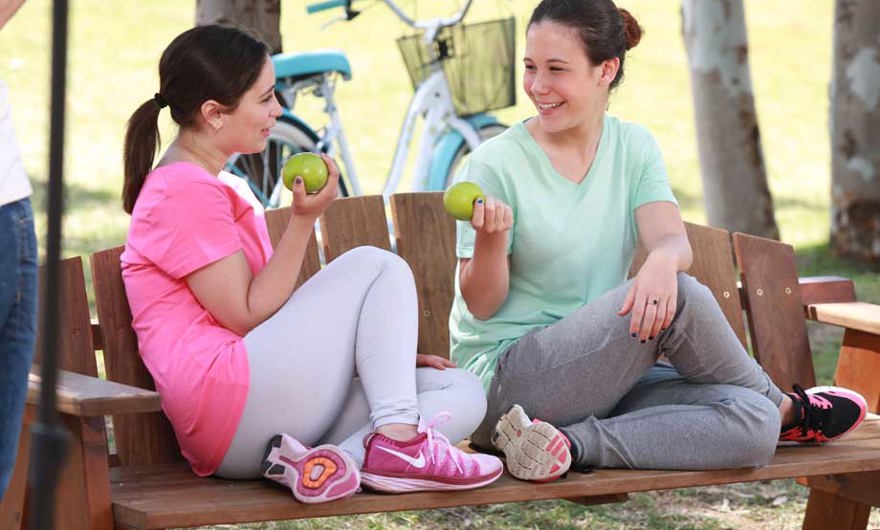
Image: Osnat Rom
No longer children, not yet adults
Physical changes are part of growing up. The passage from childhood to adolescence brings about rapid growth spurts in body height and width (an increase in muscle mass in boys and changes to the shape of the hips and chest in girls) and also varying degrees of weight gain for varied periods of time.
Food: an emotional issue, not just physical
Changes during adolescence are not only physical but also emotional. Stress, aggravation, happiness, sadness and even boredom can be expressed through food. Confrontations with the parents are are often hard to unavoid and can be linked to the consumption of food (family meals, restaurants etc.).
It is important and even recommended to avoid food-related confrontations, regarding both time and quantities consumed. Adolescents looking to “rebel” against parents who adhere to a healthy diet may develop unhealthy habits that last into adulthood.
What can you do?
- It’s important to try and stick to a routine of having evening meals around the family table and not in front of the TV or computer or while reading a book or doing homework.
- Food preparation can be turned into an activity shared with your teens; choosing recipes and even photographing dishes and sharing the prepared meals on social media, explaining the different raw materials and getting to know healthier preparation methods.
- Fruit and vegetables should always be available according to the new government dietary guidelines and nutritional rainbow.
- It is important to watch together content that is of interest to adolescents and discuss the contents, including the marketing and advertising methods used by manufacturers and marketers of sugar-sweetened beverages and processed foods.
- It is important to decide together that sugar-sweetened beverages do not enter the home.
More about sugar-sweetened beverages
Adolescence can be the right time to start exercising in a group: walking, running, swimming, Pilates – whatever suits your preferences and abilities. You can all decide to use the stairs instead of the elevator, too.
School cafeteria or dining hall
Many young boys and girls are at school until the late afternoon and rely on pre-prepared meals from their school’s cafeteria or dining hall. Until recently, a large portion of products on offer comprised of snacks, sweets, fatty baked goods (burekas, jachnun etc.), ice cream and naturally – sugar-sweetened beverages.
In January 2017, after a number of years of discussion and debate, the Knesset approved The Regulations for Food Quality Control and Nutrition Standards in Educational Establishments, 5768-2018. The Regulations prohibit the sale or serving of food products marked with a red warning symbol for harmful food products as well as products such as diet drinks, slushies, energy drinks, sugar and artificially sweetened beverages, fat-rich baked goods such as burekas and malawach, commercial quick preparation ready meals, salt-rich foods, high-fat spreads, fried foods, processed meat, sugar-rich foods and more. In additions, they specify the ingredients that should be used to prepare mid-morning meals in preschools, vegetarian and non-vegetarian lunches in preschools and vegetarian and non-vegetarian lunches in schools.
It is possible and even recommended to refrain from buying products for home consumption that are not allowed in schools.
Read, compare and choose healthier
In January 2020, the labeling of harmful foods with the introduction of red symbols. It is recommended to explain the meaning of the symbols to children and have them involved in the choice of healthier products instead of those with red labels.
More about red symbols on harmful food products
It is also recommended to read the list of ingredients with the kids, especially those of foods they eat, talk about the impact of the ingredients and understand together how to compare and make healthier choices between products of the same category.
More about nutrition labeling
Physical activity
Another way to maintain normal development of adolescents is by doing more physical activity. Walking, cycling or taking a scooter to school instead of taking the bus or family car will increase the daily physical activity level towards that recommended for adolescents (1 cumulative hour of aerobic and anaerobic exercises).
It is advisable to check out other types of physical activity that might be of interest to teens (such as dancing or ball games) and encourage them to participate in these, as part of a healthy lifestyle.
Further reading
Nutrition for children and adolescents, Ministry of Health’s Nutrition Division (Hebrew)
The dangers of slimming diets, Ministry of Health’s Nutrition Division (Hebrew)
The Regulations for Food Quality Control and Nutrition Standards in Educational Establishments, 5728-2018, records of The Ministry of Justice Website (Hebrew)



